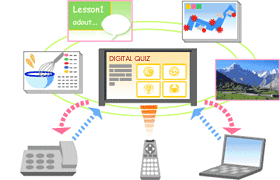Why are we switching over to digital?
HOME > Why are we switching over to digital?
Enjoy many diverse services
This migration of the television format from analogue to digital will enable viewers to enjoy a wide range of new services.In addition to digital Hi-Vision programs featuring outstanding audio and video quality, terrestrial digital TV broadcasting, features many diverse services, including interactive functions, services for the elderly and disabled, and useful regional information.
New "One-seg" services for mobile phones and other mobile devices are also being offered.

Effective use of radio waves
Radio waves are already being used at full capacity
Radio waves used for communication and broadcasting are restricted resources right now, the all of usable frequencies in Japan are filled to capacity.The switch to digital opens up space for more channels
Digital TV broadcasting will dramatically reduce the number of channels required, so that the frequencies opened up can be used effectively for other applications.Global trends
Terrestrial digital TV broadcasting first began in the UK in 1998. Now, digital broadcasting has become a global trend, with broadcasts in more than 20 countries and regions around the world, including the U.S., Germany, and Italy in the west and Korea, China, and Vietnam in Asia.
Information infrastructures
Televisions that are compatible with terrestrial digital broadcasting can access even more information if they are connected to the Internet. Promoting the shift to digital TVs so that anyone in society can enjoy the merits of telecommunication technologies is an important strategy for the future of Japan, and it is important that these measures are implemented without delay.
Copyright (C) 2007 Ministry of Internal Affairs and Communications All Rights Reserved.